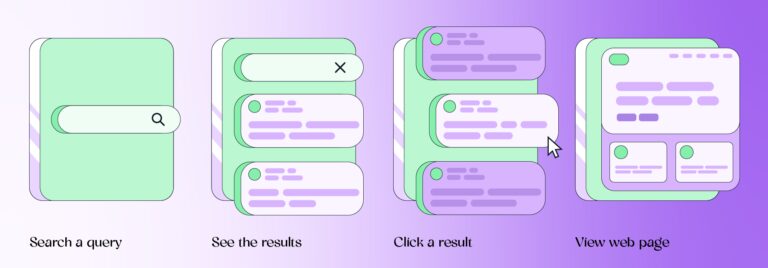Understanding user intent in SEO and SXO
5 min read

Why understanding user intent is essential for effective SEO and SXO strategies in modern search
Successful SEO strategies hinge on one key principle: understanding user intent.
Whether you’re optimising for search engines (SEO) or focusing on delivering an exceptional user experience in search and on-site (SXO), the starting point isn’t what keywords have the most volume or are easiest to rank for. It’s understanding what your audiences are searching for and more importantly, why and at what stage of the journey they are when they search; that’s user intent.
Let’s explore why user intent is key for creating hardworking strategies and how it integrates into both SEO and SXO.
What is user intent?
User intent, often referred to as search intent, represents the goal or purpose behind a user’s search query. It’s what the user hopes to accomplish when they type something into a search engine or ask their virtual assistant (think Siri or Google Assistant). The confusion arises from the term “search intent,” which many people mistakenly think is about tailoring content to meet the technical requirements of search engines rather than focusing on the actual needs of users.
In reality, user intent and search intent are the same and are used interchangeably. Both revolve around understanding and serving the user’s needs. Search engines, particularly Google, have evolved to prioritise content that does this very well (helpful content, E-E-A-T!).
It means that strategies that focus solely on search engines rather than user intent will inevitably fall short in SERPs and lose rank over time, if not instantly when Google rolls out a core update. Keyword gain is important but it’s on par with helpful and unique content that serves a user too.
User intent journey

- Search a query: a user types in a query to a search engine
- See the results: a search engine matches the intent of the query with the results
- Click a result: a user chooses a result that appeals to or seems to answer their intent
- View web page: a user lands on a web page and stays or leaves depending on the intent being met
Why user intent matters in SEO
At its core, SEO is about making websites discoverable by aligning them with what people are searching for. However, a common mistake is over-optimising for keywords (keyword stuffing) and neglecting the broader goal of understanding why a user is searching in the first place.
Successful SEO isn’t just about driving traffic, it’s about providing valuable content that satisfies the user’s intent, leading to higher engagement, trust, and conversions. When we send traffic (and this is relevant to all types: direct, organic, social, PPC) to a page that doesn’t meet user intent and expectation, we see minimal time on the page, low views per visit, low engagement and high bounce rates which lead to low or no conversion.
Types of user intent:
- Informational: The user is looking for information, answers, or knowledge about a topic. They’re likely looking for an article.
- Brand-related (navigational): The user is searching for a specific website or brand. They’re expecting to arrive on a homepage.
- Transactional: The user is ready to take an action, such as making a purchase. They looking for a product or solution/service page to buy or enquire.
- Commercial Investigation: The user is researching products or services before making a purchase decision. They may be looking for an article (a round-up, a “best” or “the top 10”) or a product page to compare.
To be successful with SEO, the on-page content must match the intent behind the search query. Users searching for “how-to” guides don’t want product pages; users ready to buy don’t want to be bombarded with unnecessary information (think pop-ups, no clear CTA or articles instead of product pages).
Aligning content with the right type of intent increases relevance, keeps users engaged, and helps search engines understand that your content provides value (and, therefore, a reason to rank!)
Why user intent matters in SXO
While SEO focuses on ensuring your site ranks well in search results, SXO (Search Experience Optimisation) takes it a step further by optimising the entire user journey from the search results page to the point of conversion. SXO emphasises being found by users and delivering a seamless, intuitive experience that meets their needs and goals once they arrive on your website.
It ensures that the page they land on matches user intent and that their onward journey from said page continues to offer an enjoyable and considered experience.
If a person lands on your site looking for product comparisons, the SXOs job doesn’t end with getting them there like SEO. You need to create an experience that provides those comparisons in a clear, accessible format by integrating user experience (UX) design principles so users can effortlessly find what they’re looking for, engage with it and convert. It prioritises reducing friction throughout the user’s journey.
Importance of user intent in SEO and SXO strategies
For both SEO and SXO to work together effectively, user intent must be at the heart of your strategy.
Matching content with user intent
When your content satisfies the user’s goal, it leads to higher engagement metrics like longer dwell times (or shorter if they’re arriving on the exact page they need depending on their intent!), lower bounce rates, and more quality conversions. It all signals to search engines that your content is valuable because users are engaging with your site in a positive way, and, therefore, it improves your performance in search.
Improving bounce rate/exit rate and dwell time
If users quickly leave your site (high bounce rate/exit rate), it’s often a sign that the content doesn’t align with their intent. Content that matches intent keeps users on your site longer (dwell time) and increases the chances of conversions. You often see with PPC that dwell time is very low because user intent isn’t met when broad matches capture keywords that don’t match intent but are semantically similar.
Building trust and authority
When you consistently provide content that answers users’ queries or helps them accomplish a goal, your site becomes a trusted resource. Search engines reward this trust by boosting your rankings and serving your website against more queries related to the content because other users have found it helpful.
In summary…
Many digital marketers and businesses still fall into the trap of thinking search intent is about meeting the needs of search engines rather than users. This is a misconception that can lead to underperforming strategies.
Search engines like Google aim to rank content that best serves the user, not the content that is merely stuffed with keywords or follows technical rules. When your content is centred around satisfying user needs, search engines naturally
User intent is the cornerstone of any hardworking SEO or SXO strategy. By centering your approach around the real needs of your audience, rather than just optimising for search engines, you create a user-friendly experience that delivers value at every touchpoint. Remember, search engines are evolving to prioritise content that meets users’ needs, so the more you focus on serving those needs, the better your website will perform.
Want to know more about SXO and putting it into practice? Watch or listen to myself and Lucy Williams—Principal Digital Designer and UX expert—talk about SXO and our process.
SXO for reaching modern audiences and search engines
5.5 min read

What is SXO?
6 min read

Why do I need an SEO strategy?
6 min read

